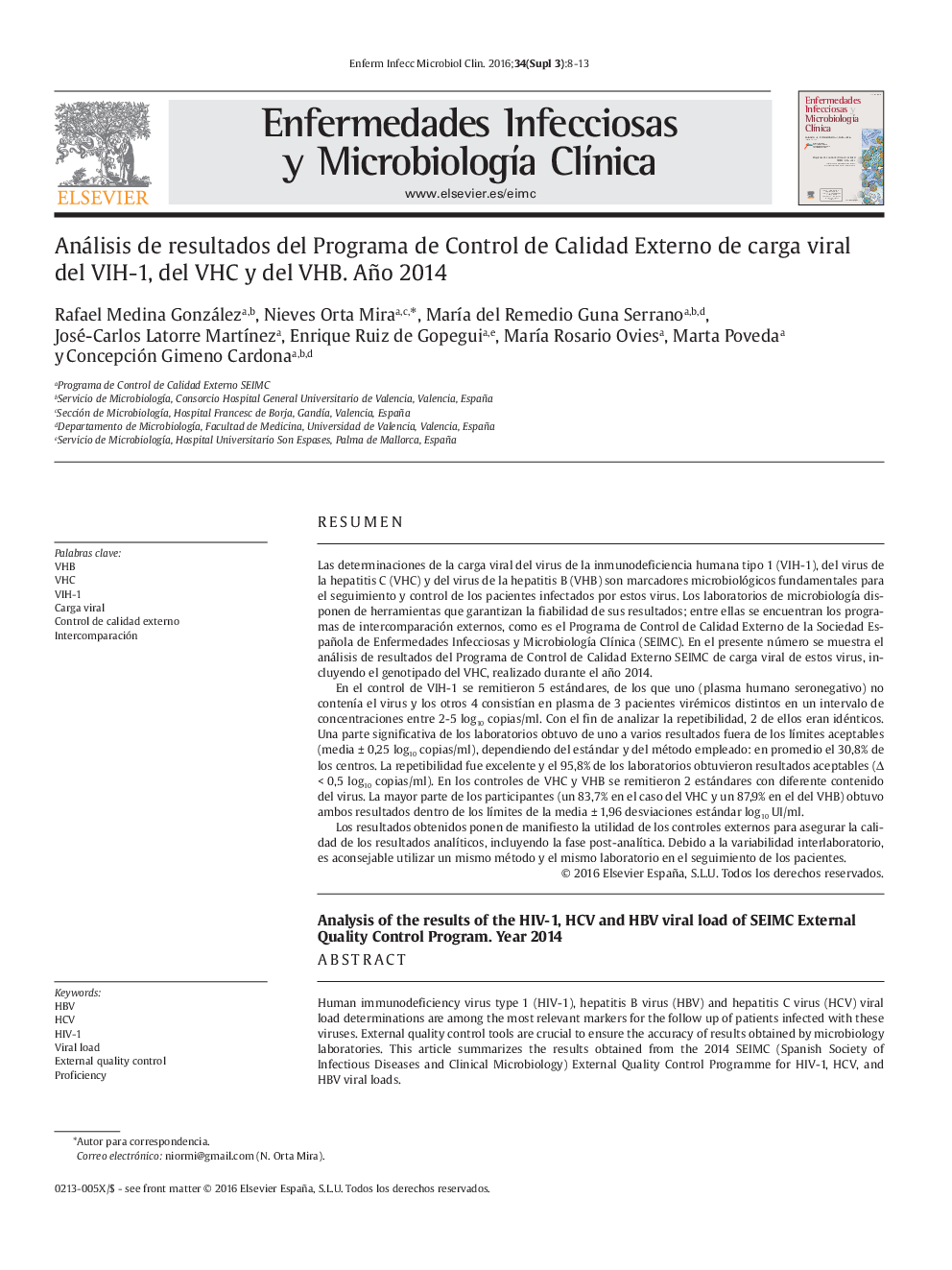| کد مقاله | کد نشریه | سال انتشار | مقاله انگلیسی | نسخه تمام متن |
|---|---|---|---|---|
| 3400751 | 1222628 | 2016 | 6 صفحه PDF | دانلود رایگان |

ResumenLas determinaciones de la carga viral del virus de la inmunodeficiencia humana tipo 1 (VIH-1), del virus de la hepatitis C (VHC) y del virus de la hepatitis B (VHB) son marcadores microbiológicos fundamentales para el seguimiento y control de los pacientes infectados por estos virus. Los laboratorios de microbiología disponen de herramientas que garantizan la fiabilidad de sus resultados; entre ellas se encuentran los programas de intercomparación externos, como es el Programa de Control de Calidad Externo de la Sociedad Española de Enfermedades Infecciosas y Microbiología Clínica (SEIMC). En el presente número se muestra el análisis de resultados del Programa de Control de Calidad Externo SEIMC de carga viral de estos virus, incluyendo el genotipado del VHC, realizado durante el año 2014.En el control de VIH-1 se remitieron 5 estándares, de los que uno (plasma humano seronegativo) no contenía el virus y los otros 4 consistían en plasma de 3 pacientes virémicos distintos en un intervalo de concentraciones entre 2-5 log10 copias/ml. Con el fin de analizar la repetibilidad, 2 de ellos eran idénticos. Una parte significativa de los laboratorios obtuvo de uno a varios resultados fuera de los límites aceptables (media ± 0,25 log10 copias/ml), dependiendo del estándar y del método empleado: en promedio el 30,8% de los centros. La repetibilidad fue excelente y el 95,8% de los laboratorios obtuvieron resultados aceptables (Δ < 0,5 log10 copias/ml). En los controles de VHC y VHB se remitieron 2 estándares con diferente contenido del virus. La mayor parte de los participantes (un 83,7% en el caso del VHC y un 87,9% en el del VHB) obtuvo ambos resultados dentro de los límites de la media ± 1,96 desviaciones estándar log10 UI/ml.Los resultados obtenidos ponen de manifiesto la utilidad de los controles externos para asegurar la calidad de los resultados analíticos, incluyendo la fase post-analítica. Debido a la variabilidad interlaboratorio, es aconsejable utilizar un mismo método y el mismo laboratorio en el seguimiento de los pacientes.
Human immunodeficiency virus type 1 (HIV-1), hepatitis B virus (HBV) and hepatitis C virus (HCV) viral load determinations are among the most relevant markers for the follow up of patients infected with these viruses. External quality control tools are crucial to ensure the accuracy of results obtained by microbiology laboratories. This article summarizes the results obtained from the 2014 SEIMC (Spanish Society of Infectious Diseases and Clinical Microbiology) External Quality Control Programme for HIV-1, HCV, and HBV viral loads.In the HIV-1 program, a total of 5 standards were sent. One standard consisted in seronegative human plasma, while the remaining 4 contained plasma from 3 different viremic patients, in the range of 2-5 log10 copies/mL; 2 of these standards were identical aiming to determine repeatability. A significant proportion of the laboratories (30.8% on average) obtained values out of the accepted range (mean ± 0.25 log10 copies/mL), depending on the standard and on the method used for quantification. Repeatability was excellent, with up to 95.8% of laboratories reporting results within the limits (Δ < 0.5 log10 copies/mL). The HBV and HCV program consisted of 2 standards with different viral load contents. Most of the participants, 83.7% in the case of HCV and 87.9% in the HBV, obtained all the results within the accepted range (mean ± 1.96 standard deviations log10 IU/mL).Data from this analysis reinforce the utility of proficiency programmes to ensure the quality of the results obtained by a particular laboratory, as well as the importance of the post-analytical phase on the overall quality. Due to the remarkable interlaboratory variability, it is advisable to use the same method and the same laboratory for patient follow up.
Journal: Enfermedades Infecciosas y Microbiología Clínica - Volume 34, Supplement 3, July 2016, Pages 8–13